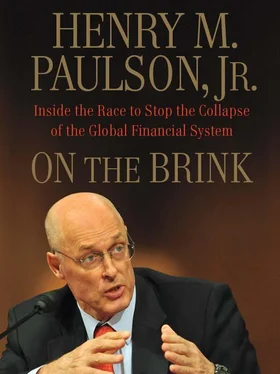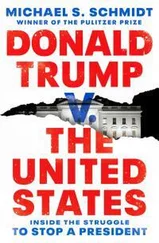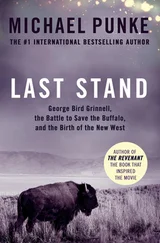So Ben threw in a crucial caveat: “I’m prepared to go ahead here only if Treasury is supportive and prepared to protect us from any losses.”
To be honest, I wasn’t sure what, if any, legal authority Treasury might have had to indemnify the Federal Reserve, but I was determined to make it to the weekend. The repo markets would open shortly—around 7:30 a.m.—and I wasn’t about to drag in a lot of lawyers and debate any legal fine points now.
“I’m prepared to do anything,” I said. “If there’s any chance of avoiding this failure, we need to take it.”
First, though, I had to get off the line and speak with President Bush to confirm that he would sign off on the plan. Yes, he said, we had his support. But now he had to scramble. That day he not only had the speech in New York at the Economic Club but also a meeting with the editorial board of the Wall Street Journal , which was renowned for its free-market views and its opposition to government interference in the economy.
I told him not to worry; Steel was on top of the Bear situation in New York and could meet him on his arrival. I reiterated, with a touch of black humor: “Mr. President, you can take out that line in your speech about ‘no bailouts.’”
The president reworked his speech, and when he flew to New York, Steel was waiting at the Wall Street Heliport. He hopped in the presidential limousine and briefed the president on the way to Midtown, bringing him up to date on Bear.
I got back on the conference call to say we had the president’s backing. Afterward Tim and I spoke privately. We were rushing this rescue through very fast. The Board of Governors of the Federal Reserve had not yet formally approved the loan, and we had not yet put out an announcement. But the market was about to open, so we needed to move rapidly.
We asked ourselves again what would happen if Bear failed. Back in 1990, the junk bond giant Drexel Burnham Lambert had collapsed without taking the markets down, but they had not been as fragile then, nor had institutions been as entwined. Counterparties had been more easily identified. Perhaps if Bear had been a one-off situation, we would have let it go down. But we realized that Bear’s failure would call into question the fate of the other financial institutions that might share Bear’s predicament. The market would look for the next wounded deer, then the next, and the whole system would be at serious risk.
I talked to Tim probably two dozen times between Friday and Sunday. We made a good team. Tim brought to the crisis a keen analytical mind and a great sense of calm, of deliberative process and control. He had great stamina and a welcome sense of humor. But although we were relying on the Fed’s powers to deal with Bear Stearns, it was uncharted water for him, and he relied on my market knowledge and my familiarity with Wall Street. Tim knew I understood the thought processes and the strengths and weaknesses of the Wall Street CEOs. I understood how to deal with boards of directors and shareholders. I knew how extraordinarily difficult it was to buy a company over a weekend with no time for due diligence. I also knew what it felt like to be afraid of losing your company, because I’d had that fear in 1994 at Goldman Sachs, when big trading losses had caused many spooked partners to withdraw their capital.
Tim had already explained the government’s plan to Bear CEO Alan Schwartz, but he was worried that Alan hadn’t completely grasped the consequences. The government didn’t put taxpayer money at risk without expecting something in return—in this case, essentially, control.
“Let’s make sure he understands, Hank,” I remember Tim saying. “You need to speak to him with force and clarity so he hears it from you and not just me.”
When I reached Alan, he sounded rattled, but it was clear that he was doing his best. I had great sympathy for him. He was a good investment banker and a highly regarded adviser to companies who had been thrust into a terrible situation that did not play to his strengths. When I called, he’d been meeting with his board, which was a fractious group.
“Alan,” I said, “you’re in the government’s hands now. Bankruptcy is the only other option.”
“Tim said the same thing to me,” he said. “I was nervous because when you called I thought maybe the rules were changing. Don’t worry. I got the message.”
Just before 9:00 a.m., JPMorgan announced that it would join with the Fed to lend to Bear Stearns for an initial period of up to 28 days. The release did not specify how much money would be lent.
I almost never let myself be scripted. I work best by writing down a few bullet points and two or three key phrases to use. Still, in a conference call soon afterward with the CEOs of all the major banks, I knew I had to be careful—I couldn’t order these bankers to do anything. But I had to make clear that if they pulled their credit lines from Bear, the investment bank wouldn’t survive the day. I told them that I understood they all had fiduciary responsibilities, but that this was an extraordinary situation and the government had taken unprecedented action.
“Your regulators have worked together to come up with a solution. We ask you to act in a responsible manner,” I said. “All of us here are thinking about the system. Our goal is to keep Bear operating and making payments.”
The group asked a lot of questions about the Fed’s emergency backstop. Tim and I let Jamie Dimon answer most of these. The bankers were nervous but obviously relieved, which gave me some comfort that Bear would make it through the day.
Initially, Bear shares rallied, but it didn’t take long for the market to weaken. During the morning, Bear’s stock plunged nearly in half, to below $30. The broader markets fell sharply, too, with the Dow Jones Industrial Average off nearly 300 points. For the day, the dollar hit a then-record low of $1.56 against the euro, while gold soared to a new high of $1,009 an ounce.
Despite the backing of JPMorgan and the Fed, doubts remained about Bear’s ability to survive. Its accounts continued to flee, draining its reserves further. We needed to get a deal done by Sunday night, before the Asian markets opened and the bank run went global.
That afternoon during a meeting on our housing initiatives, I asked Neel Kashkari if he was going to be around during the weekend, because we might need help on Bear. Neel said: “I have to imagine I’d be more useful to you in New York than sitting next to you in D.C.”
I agreed, but before he took off I said, “I am sending you to do something you are totally unqualified to do, but you’re all I’ve got.” I could always rib Neel because he was talented and self-confident.
He laughed. “Thanks, I guess.”
I called Jamie Dimon at 4:30 p.m. and told him we needed to get the deal done by the end of the weekend. Self-assured, charismatic, and quick-witted, Jamie had the ability to walk the line between being a tough businessman and knowing when to rein in his competitive instincts for the good of the financial system. He had the confidence of his board, which allowed him to make decisions quickly and stand by them. He said his team would move as fast as possible, but he knew better than to give me any guarantees.
President Bush had returned to Washington after his speech in New York and wanted an immediate briefing on Bear Stearns. When was JPMorgan going to buy the company? he asked. I told him I didn’t know, but I emphasized that something had to happen over the weekend or we would be in trouble.
In New York, Tim Geithner was growing increasingly concerned. After talking with Schwartz, he suspected that the Bear CEO didn’t realize that the day’s events had so compromised his firm that the timetable had to be accelerated. Schwartz, he said, was still operating under the illusion that he had a month to sell the company.
Читать дальше












